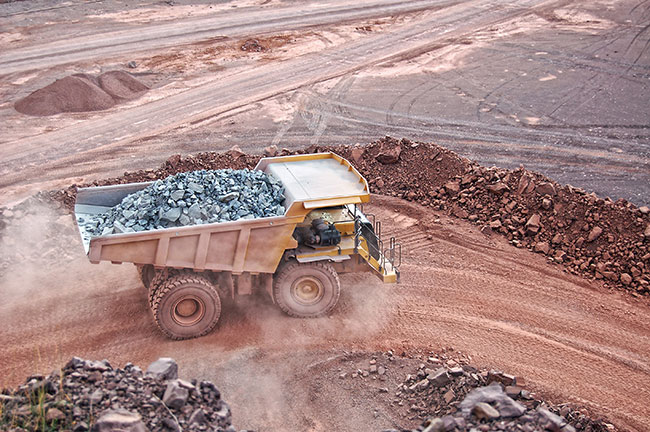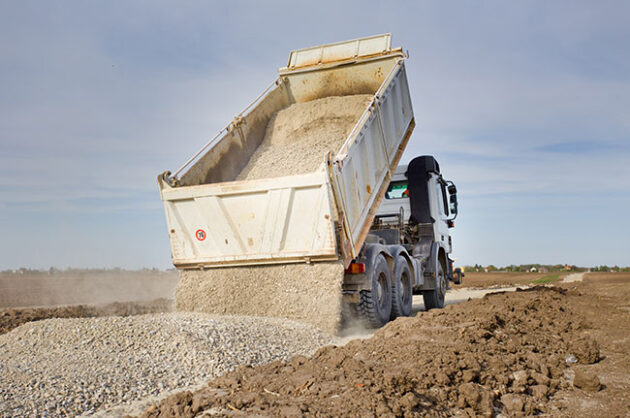
Features
Aggregates
Heavy Equipment
Roads & Paving
What’s in store for 2024
Canada’s aggregates and heavy construction associations share their New Year’s resolutions.
February 26, 2024 By Jack Burton
 Photo: Getty Images/hsvrs
Photo: Getty Images/hsvrs While some may still be struggling to avoid writing ‘2023’ on their cheques or considering dusting off that gym membership after a holiday turkey binge – we don’t blame you – Canada’s aggregates, roadbuilding and heavy construction associations have already hit the ground running on the busy year ahead.
We checked in with provincial associations across the country to get a sneak peek on what to expect from 2024, including infrastructure initiatives, moves to improve government relations and regulations, supply chain struggles and improvements to the sector’s persistent labour shortages.
Alberta: Cutting through the red tape
The Alberta Sand & Gravel Association (ASGA) sees 2024 as an opportunity to reposition the industry and its relationships with the province’s government and communities for success, with ASGA hoping to tackle a number of policy changes to remove growth ceilings and create the space for the aggregates industry to thrive.
One significant step is ASGA’s involvement in stakeholder advisory committees at the municipal level, making reviews and recommendations on their aggregate resource plans. Its first municipal collaboration began in fall of 2023, with ASGA hoping this partnership to have laid the foundation to forge similar relationships across the province.
“It’s been good to hear concerns from the citizens on the committee, but also to see their ‘I had no idea’ faces when presented with the facts of aggregate development and consumption: they’re realizing the value of aggregate, how regulated the industry currently is and learning some facts about things like land reclamation,” said Rob Fragoso, ASGA’s executive director.
A unique aspect of Alberta’s aggregates industry is the bylaw-mandated truck registry, which ASGA helps to manage and maintain. Certain municipalities require gravel trucks to be part of this registry for accountability and feedback, but ASGA is looking to make changes to the registry and its requirements this year due to rising compliance issues.
“If a truck is not in the registry where mandated and attempts to haul gravel, the owner-operator will be warned or ticketed through local bylaw enforcement. Some operators won’t even allow hauling by trucks that are not part of the registry, regardless of location,” said Fragoso.

In Prince Edward Island, a lack of close-to-market aggregate sources has made industry-wide supply chain issues, and their effects on heavy construction operations, especially felt. Photo: Adobe Stock/Elenathewise
“It’s worked well in many instances, but has been problematic at times for various reasons. At ASGA, we’re looking at some potential changes, as we have seen a marked decrease in the number of registered trucks since the beginning of the pandemic.”
The Community Aggregate Payment Levy struck between ASGA and the province is another target of the changes the association is looking to make in 2024. The initial intention, Fragoso said, was to give municipalities a direct financial benefit from local aggregate producers based on a percentage of hauled tonnage, providing operations with a way to show their direct benefit to the communities they work in and potentially ease municipal permitting and public opposition.
“That was the intent,” said Fragoso. “What’s happened, though, is many municipalities used the levy funds as general income, which they then used as wished without crediting the industry. In other words, communities are not seeing the positive impact operators have in improving local infrastructure and other projects. The agreement expires in December 2024, and I will be working with municipalities and the government on a solution that benefits all sides.”
Foundational to all these initiatives, though, is ASGA’s commitment to ensuring that the aggregate industry’s role in the provincial supply chain of infrastructure and commerce is properly recognized and accommodated at all levels, from key stakeholders to the general public.
“Without sand and gravel, you can’t have concrete, asphalt or other major infrastructure materials,” said Fragoso. “The government has infrastructure plans in place and sees its importance as the province and country continues to grow, but I’m not convinced they have a similar view of aggregates, and the risks that sterilization and over-regulation poses. Part of the plan for 2024 is to press on these issues and create awareness of it.”
Manitoba: Making moves
In Manitoba, the new provincial leadership’s priority on continuing the previous administration’s focus on infrastructure and heavy construction as a collaborative pathway to economic prosperity has left members of the industry with something to be excited about.
“We’re optimistic, given Premier Wab Kinew’s commitment to our industry being the economic horse that pulls the social cart and his view that the country needs a nation-building Canada Trade Infrastructure Plan,” said Chris Lorenc, president & CEO of the Manitoba Heavy Construction Association (MHCA).

Chris Lorenc, president & CEO of the Manitoba Heavy Construction Association, says the new provincial administration has given the industry plenty of reasons to be optimistic heading into 2024.
Kinew’s commitments have introduced several initiatives into the industry, including acting on his plans to establish a blue-ribbon advisory panel for infrastructure investments, early indications to build up Manitoba’s extraction and mining sector, improving relationships with stateside trade hubs and building up the City of Winnipeg as an economic and infrastructural leader.
“I think it’s been made very clear, with both the outgoing and new administrations, that the role of Manitoba’s transportation and infrastructure sectors need to be recognized for what they should be, which is an economic growth enabler,” said Lorenc.
The plans to reposition Winnipeg as an infrastructure hub both within and beyond Canada’s borders include the adoption of a specification review working group process, a collaborative change to how the city’s road projects will be introduced, designed, constructed and updated.
With this change, the review process for Winnipeg’s road projects is now a collaborative affair between key stakeholders including the city’s Public Works Department, the Association of Consulting Engineers, the Urban Development Institute, and the MHCA. The alignment this change has brought across key players in the city’s roadbuilding projects has the MHCA now advocating for it to be adopted at the provincial level.
“On the surface, one might say, ‘well, who cares?’ Well, we should all care. If we can streamline products from our aggregate industry, and produce it in greater volume, this volume reduces the cost of the final product, with the volume and consistency of designs reducing risks for both manufacturers and contractors during the construction or reconstruction process,” said Lorenc. “All of that has very, very positive implications on lowering costs, not just maintaining them.”
This big-picture approach to infrastructure and heavy construction gives Lorenc confidence the provincial administration is on the same page as industry leaders when it comes to viewing heavy construction as a key player on the path to developing Manitoba’s profile as a global trade hub.
“The Department of Transportation and Infrastructure should not be simply viewed as an asset manager that fixes potholes or repaves surfaces – those are aspects, certainly, but it needs to be seen as part of a larger strategy to harness investments in transportation, grow the Manitoba-U.S. economy, and enhance our trade profile not just in Western Canada, but domestically, continentally and globally,” he said.
As an association, Lorenc shared that these commitments, along with meetings between the MHCA and key figures within Manitoba’s Ministry of Transportation and Infrastructure, have positioned the association – and the province’s industries – in a beneficial vantage point heading into this year.
“All of this gives us a reason to be optimistic and excited about the prospects for economic growth in this province heading into 2024 and beyond,” he said.

Adjustments to Alberta’s trucking registry is one target of the changes that ASGA is looking to make in 2024. Photo: Adobe Stock/ Budimir Jevtic
PEI: The demand for supply solutions
On the east coast, Prince Edward Island (PEI) faces many of the same factors that have been affecting roadbuilding and heavy construction professionals over recent years, with one notable exception regarding aggregate cost and supply.
“Like most provinces, our industry struggles with labour shortages, rising costs, and availability of materials and equipment,” said Melissa Paquet, executive director of the PEI Roadbuilders & Heavy Construction Association (PEIRB). “One unique challenge to PEI, though, is that a very high percentage of our aggregates are shipping in from out-of-province, due to there being no local sources.”
The lack of close-to-market solutions across the Island means current obstacles common to the country’s heavy construction sector, such as supply chain issues and inflated material and transportation costs, are especially pronounced in the province.
“With almost no local sources, it has become a challenge to co-ordinate due to strained transportation resources and increased aggregate and shipping costs – even imported products are harder to get,” Paquet said.
These availability issues have made it more difficult for roadbuilding projects to have the resources necessary to be completed on time, while also making it more expensive for projects to effectively source these materials in the first place.
“There has been limited transportation resources available which can sometimes make it challenging to get the aggregates we require, when we need them,” said Paquet. “With aggregate being so far from our markets, we’ve seen larger transportation costs than most other provinces: trouble with gravel ships, trucks, and sources. We’re seeing increased costs to get these products there and back.”
One resource that the association is focused on making available across the province’s roadbuilding and heavy construction industry, however, is labour. With labour crunches affecting all provinces, the PEIRB is committed to making it known to the province’s workers of tomorrow that there are viable career paths within the roadbuilding and heavy construction industries.
To achieve this, the association has developed the Essential Skills Pathway, a collaborative program developed alongside the province’s Department of Education. The program connects high school students with ground-breaking technology that showcases the wide array of opportunities that a career in the province’s roadbuilding and heavy construction sectors presents.
“One of our major initiatives is our investment in the Vortex Edge Max, which simulates six different pieces of heavy machinery as part of our Essential Skills Pathway program,” said Paquet. “The end goal is to draw more youth to our industry, by showing them the great opportunities and careers available in PEI’s roadbuilding and heavy equipment operation sectors.”
The Essential Skills Pathway program is just one of several ways the association is addressing industry’s labour issues. Between participating in local job fairs, consulting with Charlottetown’s Holland College on their construction technology program and showing Canadian newcomers the viability of heavy construction as a career, the PEIRB’s commitment to addressing labour gaps is a core value informing their goals for years to come.
“Recruiting more qualified people into our industry, to fill those vacancies, is our association’s most pressing long-term goal,” said Paquet. “We want to let as many people know as possible that there are great opportunities and careers available in the roadbuilding and heavy equipment fields.”
Print this page